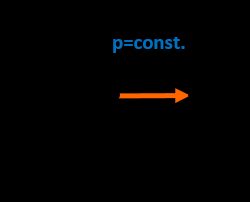Charles' Law Calculator
The Charles' law calculator is a simple tool that describes the basic parameters of an ideal gas in an isobaric process. In the text, you can find the answer to the question "What is Charles' law?", learn what the Charles' law formula looks like, and read how to solve thermodynamic problems with some Charles' law examples.
In case you need to work out the results for an isochoric process, check our Gay-Lussac's law calculator.
Charles' law definition
Charles' law (sometimes referred to as the law of volumes) describes the relationship between the volume of a gas and its temperature when the pressure and the mass of the gas are constant. It states that the volume is proportional to the absolute temperature.
There are a few other ways we can write the Charles' law definition, one of which is: the ratio of the volume and the temperature of the gas in a closed system is constant as long as the pressure is unchanged.
Charles' law describes the behavior of an ideal gas (gases that we can characterize by the ideal gas law equation) during an isobaric process, which means that the pressure remains constant during the transition.
Charles' law formula

Based on the definition of Charles' law, we can write the Charles' law equation in the following way:
V₁ / T₁ = V₂ / T₂,
where V₁ and T₁ are the initial volume and temperature, respectively. Similarly, V₂ and T₂ are the final values of these gas parameters.
How does this Charles' law calculator work? First, you need to insert three of the parameters, and the fourth is automatically calculated for you. Let's say we want to find the final volume, then the Charles' law formula yields:

V₂ = V₁ / T₁ × T₂.
If you prefer to set the final volume and want to estimate the resulting temperature, then the equation of Charles' law changes to:
T₂ = T₁ / V₁ × V₂.
In the last group of variables, you can also define the pressure and see how many moles of atoms or molecules there are in a container.
💡 If the temperature is constant during the transition, it's an isothermal process. In such a case, you can quickly estimate its parameters with Omni's Boyle's law calculator!
Charles' law examples
We can use Charles' law calculator to solve some thermodynamic problems. Let's see how it works:
-
Imagine that we have a ball pumped full of air. Its initial volume is equal to
2 liters, and it lies on a beach where the temperature is35 °C. We then move it to an air-conditioned room with a temperature of15 °C. How does the volume of the ball change?-
First of all, the Charles' law formula requires the absolute values of temperatures so we have to convert them into Kelvin:
T₁ = 35 °C = 308.15 K,
T₂ = 15 °C = 288.15 K. -
Then we can apply the Charles' law equation in the form where the final volume is being evaluated:
V₂ = V₁ / T₁ × T₂
= 2 l / 308.15 K × 288.15 K
= 1.8702 l.
We can see that the volume decreases when we move the ball from a warmer to a cooler place. Sometimes you can experience that effect while changing your location or simply leaving an object alone when the weather turns. The ball seems under-inflated, and somebody may think there is a hole, causing the air to leak. Fortunately, it's only physics, so you don't have to buy another ball – just inflate the one you have and enjoy!
One tiny remark – air is an example of a real gas, so the outcome is only an approximation, but as long as we avoid extreme conditions (pressure, temperature). The result is sufficiently close to the actual value.
-
-
In the second problem, we heat an easily-stretched container. It's filled with nitrogen, which is a good approximation of an ideal gas. We can find that its initial volume is
0.03 ft³at room temperature,295 K. Then we put it close to the heating source and leave it for a while. After a few minutes, its volume has increased to0.062 ft³. With all of this data, can we estimate the temperature of our heater?-
Let's apply the Charles' law formula and rewrite it in a form so that we can work out the temperature:
T₂ = T₁ / V₁ × V₂
= 295 K / 0.03 ft³ × 0.062 ft³
= 609.7 K. -
We can write the outcome in the more amiable form T₂ = 336.5 °C or T₂ = 637.7 °F.
This is a great example that shows us that we can use this kind of device as a thermometer! Well, it's not a very practical method and is probably not as precise as the common ones, but it still makes you think, what other unusual applications can you get from other everyday objects?
-
What is Charles' law application in real life?
There are actually various areas where we can use Charles' law. Here is a list of a few of the most popular and intriguing examples:
-
Balloon flight – You must have seen a balloon in the sky at least once in your life. Have you ever wondered how it is possible for it to fly and why they are equipped with fire or other heating sources on board? Charles' law is the answer! Whenever the air is heated, its volume increases. As a result, the same amount (mass) of gas occupies a greater space, which means the density decreases. The buoyancy of the surrounding air does the rest of the job, so the balloon begins to float.
The steering at any given direction is probably a different story, but we can explain the general concept of the up and down movement with Charles' law.
-
Liquid nitrogen experiments – Have you ever seen an experiment where someone puts a ball or balloon inside a container filled with liquid nitrogen and then moves outside? Firstly, it shrinks no matter how big it is at the beginning. Then, after it is freed, it returns to its initial state. Once again, whenever the temperature changes, so does the volume.
-
Thermometer – As shown in the previous section, it is possible to construct a device that measures temperature based on Charles' law. Although we must be aware of its limitations, which are basically the object's tensile strength and resistance to high temperatures, we can invent an original device that works perfectly to suit our needs. Whenever you are uncertain about the outcome, check this Charles' law calculator to find the answer.
Other thermodynamic processes
Charles' law, Boyle's law, and Gay-Lussac's law are among the fundamental laws which describe the vast majority of thermodynamic processes. We have gathered all of the basic gas transitions in our combined gas law calculator, where you can evaluate not only the final temperature, pressure, or volume but also the internal energy change or work done by gas.
What is a Charles' law?
Charles's law states that the volume (V) of a gas is directly proportional to the temperature (T) when pressure is kept constant. The temperature must be measured with the Kelvin scale. When we compare the substance under initial (V₁, T₁) and final conditions (V₂, T₂), you can write Charles' law as V₁/T₁ = V₂/T₂. As the temperature increases, the volume of gas also increases proportionally.
When was Charles' law discovered?
The law was experimentally determined by ballooning pioneer Jacques Charles in 1787. Unfortunately, Charles never published the work for which he is remembered. Similar studies had been carried out 100 years earlier by Guillaume Amontons, and in 1808 Joseph Gay-Lussac made the final measurements and published generalized results for gases.
How can I find T₂ in Charles' law equation?
Let's say the volume of gas was compressed from 3 liters to 2 liters at an initial temperature of 25°C. To find T₂ (final temperature) in Charles' law:
- Convert initial temperature T₁ to the Kelvins: T₁ + 273.15 = 298.15 K.
- Solve Charles' law for T₂: T₂ = (T₁×V₂)/V₁.
- Enter data: T₂ = (298.15 K×2 L)/3 L = 198.77 K.
What is the initial volume if gas was heated from 270°C to 342°C?
662.2 mL, assuming that the final volume is 750 mL. To calculate this:
- Convert temperatures to Kelvins: T₁ = 543.2 K, T₂ = 615.2 K.
- Write Charles' law: V₁/T₁ = V₂/T₂.
- Solve for V₁: V₁ = (T₁×V₂)/T₂.
- Substitute values: V₁ = (543.2 K×750 mL)/615.2 K = 662.2 mL.
What are the limitations of Charles' law?
Charles' law can only be applied to ideal gases (gases whose molecules neither attract nor repel each othert). Charles' law is valid for real gases only in the high-temperature range and at low pressures. Note that the relationship between volume and temperature is not linear at high pressures.